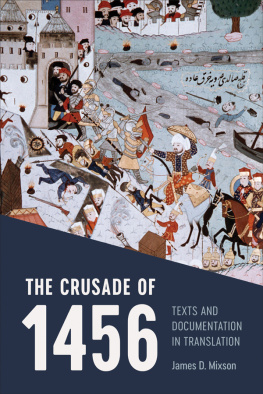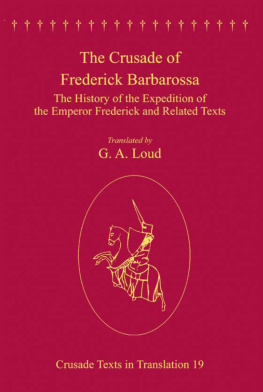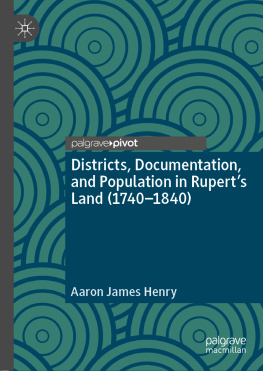James D. Mixson - The Crusade of 1456: Texts and Documentation in Translation
Here you can read online James D. Mixson - The Crusade of 1456: Texts and Documentation in Translation full text of the book (entire story) in english for free. Download pdf and epub, get meaning, cover and reviews about this ebook. year: 2022, publisher: University of Toronto Press, genre: Home and family. Description of the work, (preface) as well as reviews are available. Best literature library LitArk.com created for fans of good reading and offers a wide selection of genres:
Romance novel
Science fiction
Adventure
Detective
Science
History
Home and family
Prose
Art
Politics
Computer
Non-fiction
Religion
Business
Children
Humor
Choose a favorite category and find really read worthwhile books. Enjoy immersion in the world of imagination, feel the emotions of the characters or learn something new for yourself, make an fascinating discovery.
- Book:The Crusade of 1456: Texts and Documentation in Translation
- Author:
- Publisher:University of Toronto Press
- Genre:
- Year:2022
- Rating:5 / 5
- Favourites:Add to favourites
- Your mark:
- 100
- 1
- 2
- 3
- 4
- 5
The Crusade of 1456: Texts and Documentation in Translation: summary, description and annotation
We offer to read an annotation, description, summary or preface (depends on what the author of the book "The Crusade of 1456: Texts and Documentation in Translation" wrote himself). If you haven't found the necessary information about the book — write in the comments, we will try to find it.
The Crusade of 1456: Texts and Documentation in Translation — read online for free the complete book (whole text) full work
Below is the text of the book, divided by pages. System saving the place of the last page read, allows you to conveniently read the book "The Crusade of 1456: Texts and Documentation in Translation" online for free, without having to search again every time where you left off. Put a bookmark, and you can go to the page where you finished reading at any time.
Font size:
Interval:
Bookmark:

THE CRUSADE OF 1456
Texts and Documentation in Translation
JAMES D. MIXSON
UNIVERSITY OF TORONTO PRESS
Toronto Buffalo London
University of Toronto Press 2022
Toronto Buffalo London
utorontopress.com
Printed in the U.S.A.
ISBN 978-1-4875-0576-9 (cloth) ISBN 978-1-4875-3263-5 (EPUB)
ISBN 978-1-4875-2393-0 (paper) ISBN 978-1-4875-3262-8 (PDF)
All rights reserved. The use of any part of this publication reproduced, transmitted in any form or by any means, electronic, mechanical, photocopying, recording, or otherwise, or stored in a retrieval system, without prior written consent of the publisher or in the case of photocopying, a license from Access Copyright, the Canadian Copyright Licensing Agency is an infringement of the copyright law.
Library and Archives Canada Cataloguing in Publication
Title: The crusade of 1456 : texts and documentation in translation / James D. Mixson.
Names: Mixson, James D., author.
Description: Includes bibliographical references and index.
Identifiers: Canadiana (print) 20220137293 | Canadiana (ebook) 20220137331 | ISBN 9781487505769 (cloth) | ISBN 9781487523930 (paper) | ISBN 9781487532635 (EPUB) | ISBN 9781487532628 (PDF)
Subjects: LCSH: Belgrade (Serbia) History Siege, 1456 Sources.
Classification: LCC DR2119 .M59 2022 | DDC 949.71/013 dc23
We welcome comments and suggestions regarding any aspect of our publications please feel free to contact us at news@utorontopress.com or visit us at utorontopress.com.
Every effort has been made to contact copyright holders; in the event of an error or omission, please notify the publisher.
We wish to acknowledge the land on which the University of Toronto Press operates. This land is the traditional territory of the Wendat, the Anishnaabeg, the Haudenosaunee, the Mtis, and the Mississaugas of the Credit First Nation.
University of Toronto Press acknowledges the financial support of the Government of Canada and the Ontario Arts Council, an agency of the Government of Ontario, for its publishing activities.

For my students
The origins of this book reach back some twenty years, when as a graduate student specializing in late-medieval religion I first encountered the story of John of Capistrano and Belgrade. Not long after, I found myself as a novice teacher trying to help students make sense of the world in the early years of a new millennium, and like so many others, I was drawn anew to the teaching and study of the crusades. In that setting I became, again like so many others, more and more aware of the richness of the later medieval period for the study of the crusades, but at the same time aware of the comparative lack of affordable, widely available translations of the periods source material.
As the idea of this project began to take on a clearer shape, it came to enjoy generous institutional support. Leave time and funding from the University of Alabama helped both launch and finish it. My thanks especially to the Research Advisory Council grants program of the Office of Academic Affairs, and to the College Academy of Research, Scholarship, and Creative Activity (CARSCA) in the universitys College of Arts and Sciences. Along the way the faculty and staff of several libraries helped me immensely in accessing both manuscript and printed editions for the volume, especially the staff at the Hill Monastic Manuscript Library at St. Johns University in Collegeville, Minnesota; the Vatican Secret Archive in Rome; the Bavarian State Library in Munich; and the Amelia Gayle Gorgas library at the University of Alabama.
The project has also enjoyed the generous support of a wide circle of specialists, colleagues, and friends. Norman Housley offered early encouragement and advice and helped me think through first approaches to the project. Mark Whelan read and carefully critiqued an early draft of the Introduction. Paul Cobb and Dimitri Kastritsis kindly helped an awkward interloper negotiate the rich world of early Ottoman historiography and sources, which is unfortunately still only dimly captured in the work presented here. With the same collegiality, Aleksandar Fotic and Ognjen Krei kindly helped with first approaches to Serbia and its wider region, and especially to the later-medieval history of Belgrade. Letizia Pellegrini, Filippo Sedda, and Marco Bartoli offered warm welcomes in Italy when I first began to think about this kind of a project. Gbor Klaniczay, Stanko Andri, and Otto Gecser were always helpful in their responses to my many emails and have kindly provided me early access to their new editions of Capistranos letters. Closer to home, Christine Caldwell Ames, David Bachrach, Michael Bailey, and Laura Smoller all offered their insight and encouragement at key points. But among my greatest debts are those I owe to my colleagues at the University of Alabama. Daniel Riches, Tanja Jones, and the members of our interdisciplinary community of medieval and early modern scholars offered support all along the way. I also owe a special debt to those who helped save me from myself as I fought through so many intractable passages thanks to Daniel Riches, Kirk Summers, and Kelly Shannon Henderson for the Latin ones; Jessica Goethals for the Italian; and Rasma Lazda-Cazers for the German. Two former students, Michael Cervera and Gray Wood, read the completed draft carefully and offered valuable insights as veterans of my courses. Thanks as well to Craig Caldwell and the talented staff of the cartography lab of the University of Alabama, and especially to Alex Fries and Amber Chan for their work in preparing the maps. Yet for all this vital assistance and support, any mistakes found lurking in the volume of course remain entirely my own responsibility.
My guides through the publication process have also been invaluable. George Thompson has remained a steady and encouraging guide from the beginning. Natalie Fingerhut, Janice Evans, and the staff at the University of Toronto Press have been kind advocates and efficient colleagues on the long road to publication. I owe special thanks as well to the anonymous reviewers for the University of Toronto Press, who as specialists in crusade studies, Ottoman history, and Byzantine history offered perspective, critiques, and insights that strengthened the volume as a whole. My thanks as well to the scholars whose translations appear here alongside my own, and to all who have granted permission for the reproduction of their work.
As always, I am grateful to my wife Ashley and our family for their continued support during extended projects such as these. But above all, for this volume I am grateful to the now hundreds of students who have inspired me over so many years. They have lived through times that might seem to rival the Middle Ages for their chaos seemingly endless wars, economic and political crises, and now a world-wide pandemic, with all of its bitter consequences. They have survived it all with resilience, diligence, and enthusiasm. It is to them, and especially to the seasoned veterans of HY 300, 388, and 442, that I dedicate these translations.
This volume, like so many others of its kind, presents a kaleidoscope of premodern names and places that are often difficult to render consistently in modern English. Centuries of change, so many linguistic divides, modern scholarly conventions, and a range of other factors make for a variety of possibilities. For the most part I have sought to render that variety in standard English (e.g., John for Johannes, Giovanni, Jnos, and so on), and also to establish as much consistency and uniformity as possible among so many modern standards (so Ladislaus for Ladislas or Vladislav, Callixtus for Calixtus, Callistus, and so on). There are exceptions for translations reprinted here under copyright, where the original text remains unchanged, as well as other instances where my efforts at consistency have no doubt failed. In any event it is my hope that the text remains, above all else, readable and useful for its audience.
Font size:
Interval:
Bookmark:
Similar books «The Crusade of 1456: Texts and Documentation in Translation»
Look at similar books to The Crusade of 1456: Texts and Documentation in Translation. We have selected literature similar in name and meaning in the hope of providing readers with more options to find new, interesting, not yet read works.
Discussion, reviews of the book The Crusade of 1456: Texts and Documentation in Translation and just readers' own opinions. Leave your comments, write what you think about the work, its meaning or the main characters. Specify what exactly you liked and what you didn't like, and why you think so.








